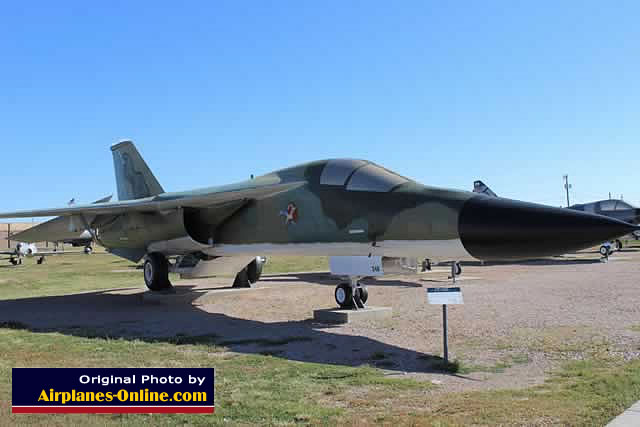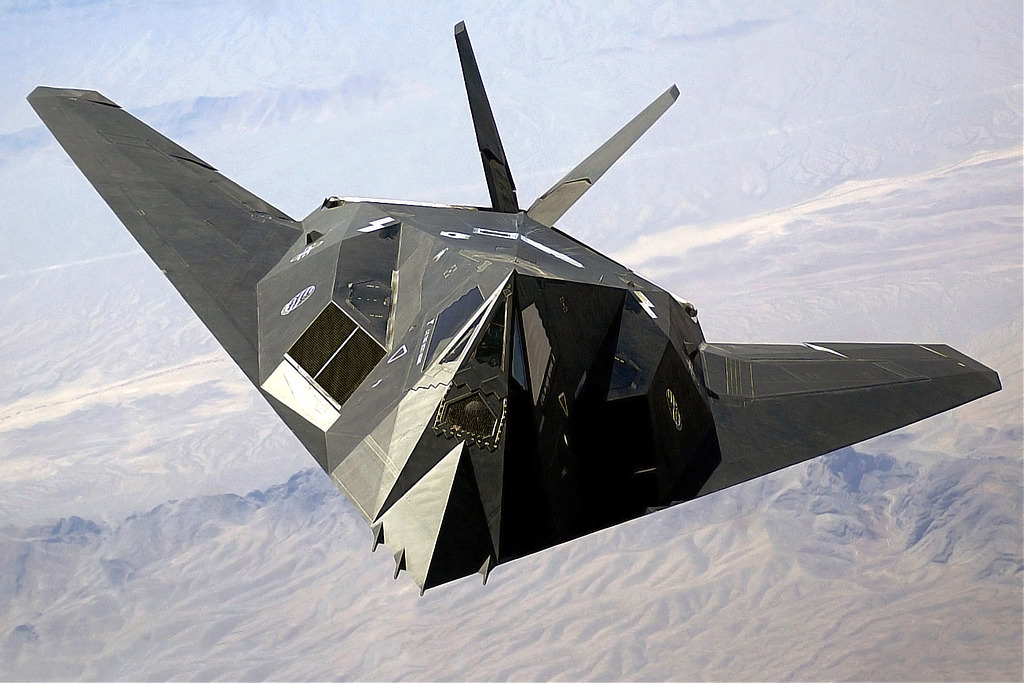U.S. Air Force Century Series
The Century Series was a group of U.S. military fighter and interceptor aircraft from the F-100 to the F-106. The series included the first successful supersonic aircraft designs in the United States Air Force's service, and remained in active service into the 1970s and 1980s with the Air Force Reserve and Air National Guard.
The Century Series aircraft represented a mix of fighter-bombers (F-100, F-101A, F-105) and pure interceptors (F-101B, F-102, F-104, F-106).
The early "Century Series" of United States Air Force jet fighters and interceptors Counterclockwise from the bottom: F-104, F-100, F-102, F-101, F-105 ... and the F-106 added later |
 |
USAF "Century Series" aircraft in flight F-100 (bottom), F-104 (left), F-101 (top) and F-102 (right) |
 |
F-100 Super Sabre
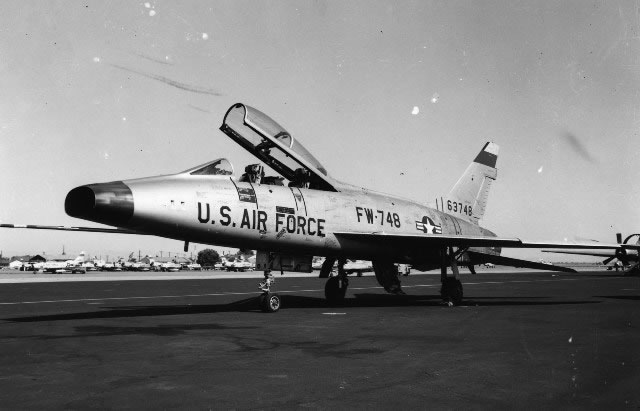 F-100 Super Sabre S/N 63748, Buzz Number FW-748 |
The F-100 Super Sabre was the first member of the "Century Series", a swept-wing supersonic jet that served in the U. S. Air Force from 1954 to 1971. It remained active in the Air National Guard until 1979.
The F-100 was the first Air Force jet fighter plane capable of supersonic speed in level flight. In addition to its nuclear bomb armament and four 20 mm cannons, the Super Sabre could be equipped to fire rockets and missiles, including the heat-seeking the GAR-8 Sidewinder. The F-100 had a service ceiling above 50,000 feet and a range of more than 1,000 statute miles.
Read more about the North American Aviation F-100 Super Sabre
North American F-100A Super Sabre 53537, Buzz Number FW-537 |
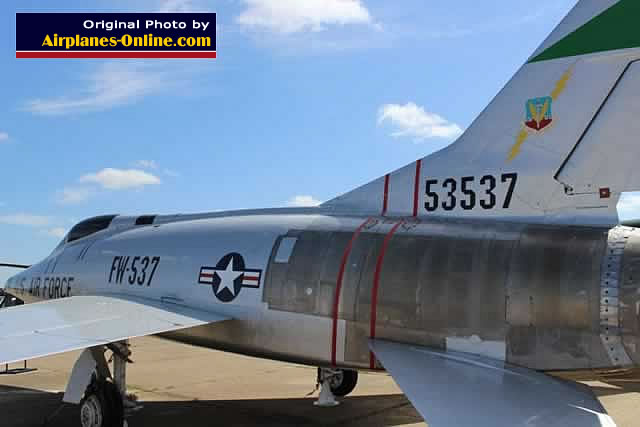 |
F-101 Voodoo Fighter
 |
The McDonnell F-101 Voodoo was a supersonic fighter plane designed to escort bombers and serve as a fighter bomber, an all-weather interceptor and a photo reconnaissance aircraft. It served during the Cuban Missile Crisis and during the Vietnam War.
The Voodoos were designed as long-range, twinjet fighters to escort bombers, attack distant targets and provide close support for ground troops. Attack fighter, interceptor and reconnaissance versions served with the U.S. Air Force Strategic Air, Air Defense and Tactical Air Commands and in Canada.
The F-101 made its first flight on September 29, 1954. The first production F-101A became operational in May 1957, followed by the F-101C in September 1957 and the F-101B in January 1959.
A total of 807 F-101 aircraft were produced. The last Voodoo was retired in 1986.
Read more about the McDonnell F-101 Voodoo
F-101 Voodoo, S/N 90418, on display at the March Field Air Museum in California |
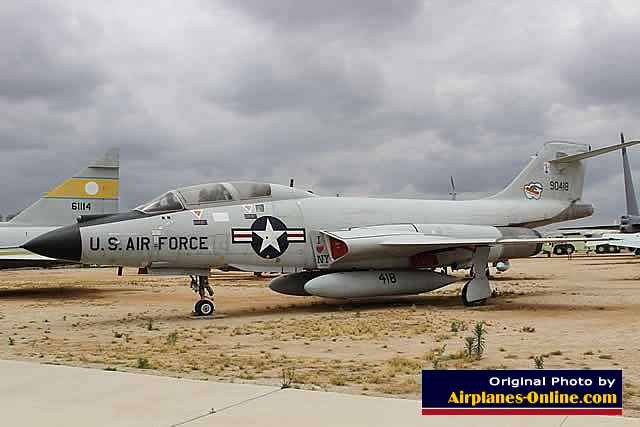 |
F-102 Delta Dagger
 |
Faced with the new threat of a Soviet long range bomber attack aimed at American soil, the U.S. Air Force requested design proposals from aviation manufacturers for a supersonic interceptor.
The "1954 Interceptor" program specified an aircraft able to reach an altitude of 50,000 feet in four minutes, and that could be in service by 1954.
On September 11, 1951 Convair's proposal, the YF-102A, was chosen by the Air Force.
Based on the first powered delta winged aircraft, the XF-92A, the Delta Dagger became the first all weather Interceptor capable of supersonic speeds in level flight, and the first aircraft designed with an all missile armament.
Read more about the Convair F-102 Delta Dagger
Convair F-102 Delta Dagger S/N 56-1393, Buzz Number FC-393 |
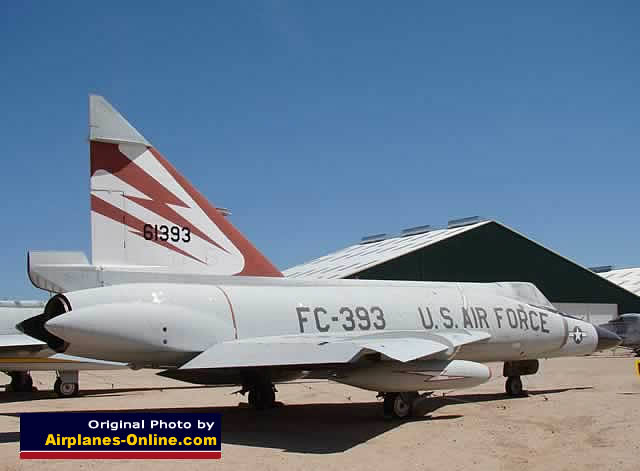 |
F-104 Starfighter
Design of the F-104 began in November 1952, as a result of the U.S. Air Force's requirement for a superior day fighter plane. The Air Force chose Lockheed's solution, the Starfighter.
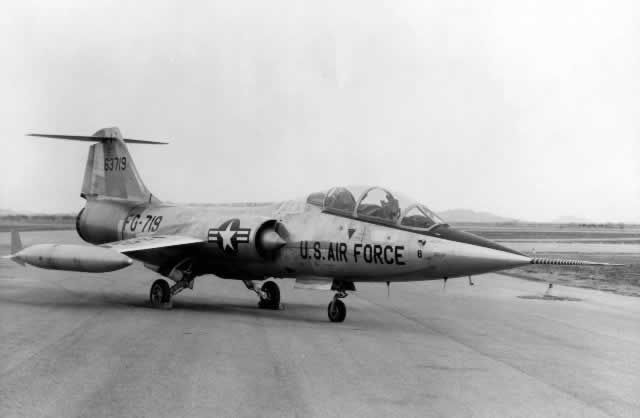 |
The aircraft was quickly nicknamed "the missile with a man in it," since its long, thin fuselage and stubby wings resembled a missile more than a conventional aircraft. The F-104 was the first interceptor in service to be able to fly at sustained speeds above Mach 2 (twice the speed of sound).
The Starfighter’s design was radical for its time, as it was a small, straight-wing aircraft while most contemporary designs were much larger and featured swept-back wings.
The first F-104A deliveries took place on January 26, 1958. The planes were delivered to the 83d Fighter-Interceptor Squadron at Hamilton Air Force Base, California. Soon afterward, pilots from this squadron set new world speed and altitude records.
Read more about the Lockheed F-104 Starfighter
Lockheed F-104 Starfighter at the Historic Aviation Memorial Museum in Tyler, Texas |
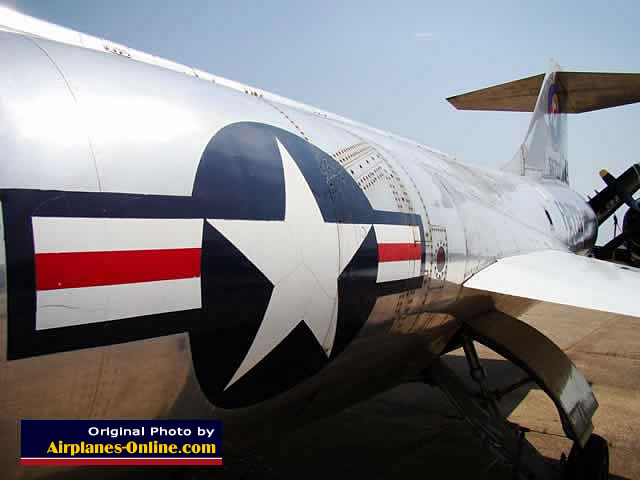 |
F-105 Thunderchief
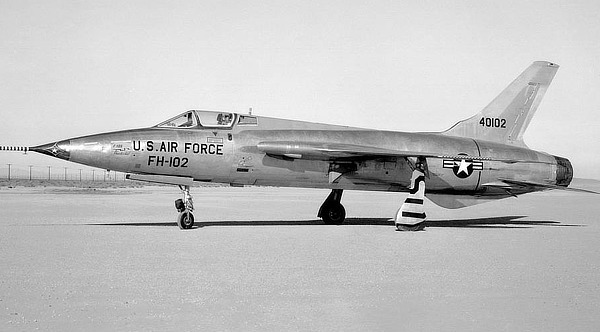 |
The Convair F-106 Delta Dart was a supersonic fighter-bomber capable of Mach-2 speeds. The aircraft was initially an internal Republic project designed to replace the RF-84F Thunderflash.
The U.S. Air Force awarded Republic with a contract for 199 aircraft in September of 1952, but later downgraded the order in size. Near the end of 1953, the entire program was canceled by the Air Force due to a number of delays and uncertainties regarding the aircraft.
In 1954, it placed another order, and the YF-105A prototype first flew in October of 1955. The first production F-105B was accepted by the Air Force in May of 1957.
In June 1957 Republic Aviation requested that the F-105 be named Thunderchief, continuing the sequence of the company's Thunder-named aircraft, e.g. P-47 Thunderbolt, F-84 Thunderjet, and F-84F Thunderstreak.
Read more about the Republic Aviation F-105 Thunderchief
F-105 Thunderchief, S/N 57-803, on display at the March Field Air Museum in California |
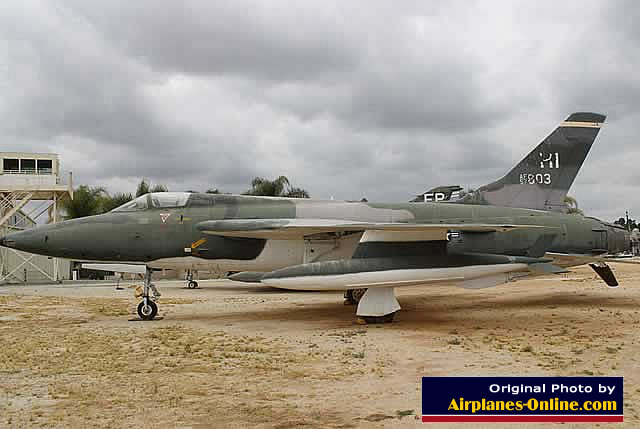 |
F-106 Delta Dart
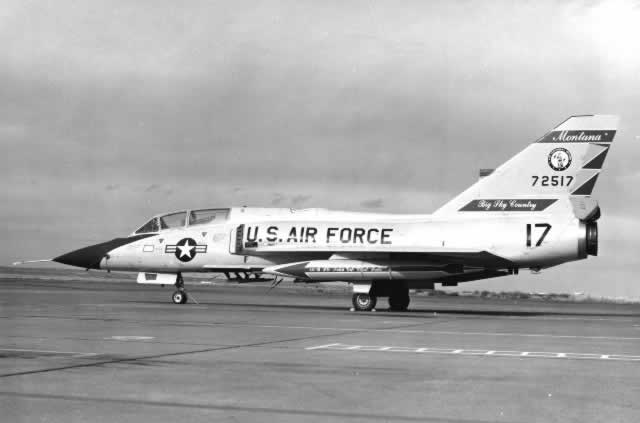 |
The Convair F-106 Delta Dart was the primary all-weather interceptor aircraft for the U.S. Air Force from the 1960s through the 1980s.
The F-106 was envisioned as a specialized all-weather missile armed interceptor to shoot down bombers. Its design was evolved from the F-102 Delta Dagger, also built by Convair.
The first F-106A flew on December 26, 1956, and deliveries to the Air Force began in July of 1959. Production ended in late 1960.
Read more about the Convair F-106 Delta Dart
Convair F-106A Delta Dart S/N 59-0003 in Tucson at the Pima Air & Space Museum |
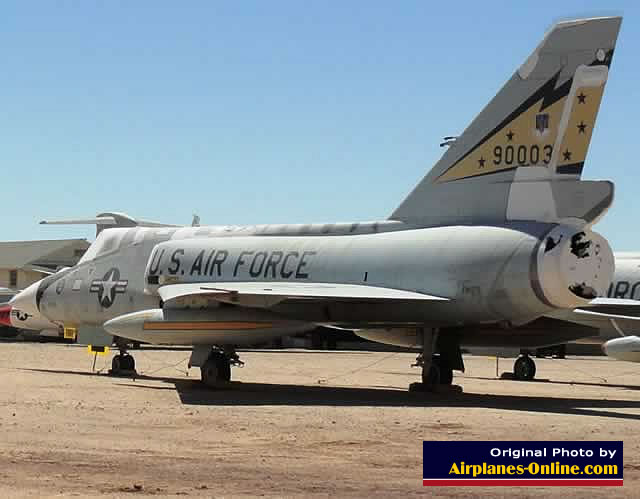 |
Other F-1xx Aircraft ... and Some Missing Ones
While the designation "Century Series" commonly refers to only the F-100, F-101, F-102, F-104, F-105 and F-106, there have been other aircraft in the "one hundred" series.
F-103
|
The Republic XF-103 (AP-57) was designed to be a powerful, delta-wing missile-armed interceptor aircraft capable of destroying Soviet bombers while flying at speeds as fast as Mach 3.
A contract for three prototypes was awarded to Republic in June 1954. Despite a lengthy development, it never progressed past the mockup stage and the project was cancelled in August of 1957.
F-107
The North American F-107 was based on the F-100 Super Sabre, and included many innovations and radical design features such as the over-fuselage air intakes. The competition for this generation of aircraft was eventually won by the Republic F-105 Thunderchief, and most of the F-107 prototypes ended their lives as test aircraft. Never officially named by the Air Force, it has been known as the "Super Super Sabre" and the "Ultra Sabre".
Only three prototypes were built. One is on display at the Pima Air & Space Museum in Tucson and a second at the National Museum of the U.S. Air Force (see photos below).
Read more about the North American Aviation F-107A Ultra Sabre
F-107A at the Pima Air & Space Museum (Staff Photo)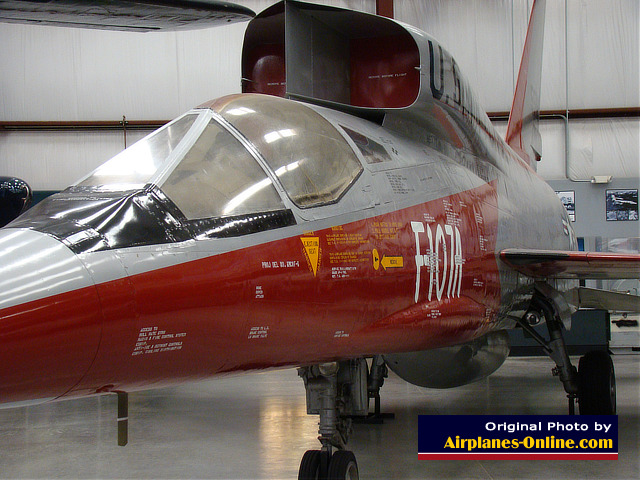 |
F-107A at the Museum of the U.S. Air Force (Staff Photo) |
F-108
The North American Aviation XF-108 Rapier was a proposed long-range, high-speed interceptor aircraft designed to defend the U.S. against supersonic Soviet strategic bombers. The delta-wing aircraft was intended as a replacement for the Convair F-106 Delta Dart. The aircraft would have cruised at speeds near Mach 3, and was equipped with radar and missiles offering engagement ranges up to 100 miles against bomber-sized targets.
The F-108 program shared engine development with the North American XB-70 Valkyrie strategic bomber program, but was cancelled in 1959 and never went into production.
F-109
|
The designation "F-109" was never officially allocated to any fighter program. This designation is sometimes attributed to the Bell Model D-188 supersonic VTOL fighter project of the late 1950s. "F-109" was also requested for the two-seat interceptor version of the F-101 Voodoo (but was subsequently numbered F-101B).
F-110
Two U.S. Navy F4H-1s (BuNos 149405 and 149406) were delivered to Langley AFB in Virginia for evaluation for use by the U.S Air Force. They were painted in USAF markings with the designation "F-110A" prominently displayed on the nose.
The F-110A Spectre was in the prototype stage when the designation was changed to F4C Phantom II. The first production USAF F4C (62-12199) had its first flight in May of 1963.
F-111
|
The F-111 was designed to meet U.S. Air Force and U.S. Navy requirements for a tactical fighter bomber. The Air Force was looking for a less expensive substitute for the B-1 penetration bomber, and a replacement for the B-58 and early model B-52s.
It was the first production swing-wing aircraft. The wings are set forward when more lift is needed, for takeoffs and landings or low speed flight. They are retracted for high speeds to reduce aerodynamic drag on the aircraft.
The USAF's F-111A first flew in December 1964, and the first production models were delivered to the USAF in 1967. However, the Navy's F-111B program was canceled. In all, 566 F-111s of all series were built; 159 of them were F-111As.
The General Dynamics FB-111 was SAC’s medium-range bomber, capable of flying supersonic speeds at 200 feet above the ground and twice the speed of sound above 35,000 feet.
Read more about the General Dynamics FB-111 Aardvark
F-112 to F-116
In the late 1960s the U.S. Air Force began to acquire Soviet fighter aircraft for the purpose of evaluation and air-to-air combat training. The acquisition and use of these aircraft was highly secret, and operations were flown from the test facility at Groom Lake, Nevada (Area 51).
|
It is thought that these Soviet fighters obtained by the U.S. were given F-xxx series numbers for their evaluation by U.S. pilots.
F-117
The Lockheed F-117 Nighthawk is a single-seat, twin-engine stealth attack aircraft developed by Lockheed's secretive Skunk Works division and operated by the United States Air Force (USAF). It was the first operational aircraft to be designed around stealth technology.
The aircraft achieved initial operational capability in 1983 but was kept under the strictest of secrecy for many years. It wasn’t until 1988 that the program was publicly acknowledged, and not until 1990 that it made its first formal public appearance.
A total of 64 F-117s were built, 59 production versions and 5 prototypes.
Read more about the Lockheed F-117 Nighthawk




